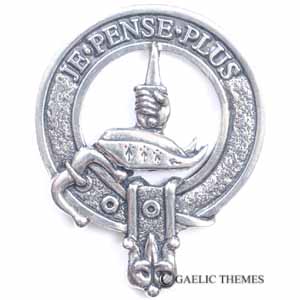Erskine
Select
- Clan Motto: Je pense plus (I Think More)
- Notes:
Crest: On a chapeau Gules furred Ermine, a hand holding up a skene in pale Argent
The ancient meaning of Erskine is “green rising ground” and the name is derived from the lands of Erskine on the south of the Clyde in Renfrew.
Henry de Erskine controlled the barony during the reign of Alexander II and was witness to a charter by the Earl of Lennox to the Abbey of Paisley around 1226. The 1296 Ragman Roll listing the names of Scottish nobles who submitted to Edward I of England includes one John de Irskyn.
His son, Sir John, had a son and three daughters, the eldest of whom married Thomas Bruce, brother of Robert the Bruce. The second daughter, Alice, married Walter the High Steward of Scotland.
No surprise, the Erskines were steadfast supporters of the Bruce family. Sir Robert de Erskine was appointed by David II constable and keeper of the vital Stirling Castle (the title is still held by the current Erskine chief). In 1330 Robert was also appointed Lord Great Chamberlain. In 1371 was one of the nobles who established the succession of Robert II, grandson of the Bruce and first king of the Stewart dynasty. The Erskines would in time be guardians to five successive generations of royalty.
In 1435 the family claimed one of the great Celtic titles when Alexander, Earl of Mar, died. Alexander was a Stewart, and the title had come through his wife the Countess of Mar. Sir Robert Erskine, now also Lord Erskine, claimed the earldom by right of his descent from Isabella, Countess of Mar.
In 1497, Alexander, third Lord Erskine, built the massive tower at Alloa which would be the family seat for the next three hundred years. As a baby, Mary Queen of Scots was protected by the Erskines. She spent the first five years of her life at Alloa and Stirling. It was she who bestowed upon Lord Erskine the title of ‘Earl of Mar’ (a title which caused some political turmoil in years to come).
In 1582, Lord Erskine participated in the famous raid on Ruthven, which placed the young James VI in the hands of a group of Protestant extremist nobles for a year. Erskine was exiled for this error, but was later restored and became Lord High Treasurer in 1616.
The sixth Earl of Mar, born in 1675 earned the epithet of “Bobbing John” - what we might call a “flip-flopper” today. John first supported the Union and the Hanoverian succession. However, in 1714 he was passed over for the post of Secretary of State for Scotland, which he apparently felt was his due for loyal service. Insulted, John went home and turned out the clan for the Old Pretender, James VIII. Calling to any loyal Jacobites, he eventually raised over ten thousand clansmen. His force met the Duke of Argyll at Sheriffmuir on November 13, 1715. Mar’s forces technically won the day, but without severely damaging Argyll’s force. And Argyll himself also claimed a victory. Ultimately the uprising failed and Mar fled to France, forfeiting his lands and titles.
The Erskine estates were purchased by another branch of the family in 1724. The earl received the Jacobite title of Mar. In 1824, when the Erskines were restored to the earldom of Mar, the Jacobite title was dropped.
